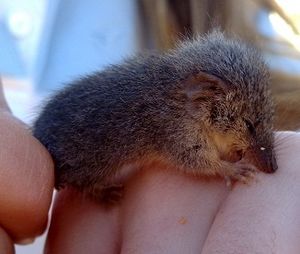Ningauis facts for kids
Quick facts for kids Ningauis |
|
|---|---|
 |
|
| Southern ningaui | |
| Scientific classification |
|
| Kingdom: | Animalia |
| Phylum: | Chordata |
| Class: | Mammalia |
| Infraclass: | Marsupialia |
| Order: | Dasyuromorphia |
| Family: | Dasyuridae |
| Subfamily: | Sminthopsinae |
| Tribe: | Sminthopsini |
| Genus: | Ningaui Archer, 1975 |
| Type species | |
| Ningaui timealeyi Archer, 1975
|
|
| Species | |
Ningaui is a genus of super tiny marsupials that live in Australia. They are part of the Dasyuridae family, which includes other meat-eating marsupials like quolls and Tasmanian devils. Along with planigales, ningauis are among the smallest marsupials in the world, even smaller than some mice!
Contents
Discovering Ningauis
The name Ningaui was first used in 1975 by a scientist named Mike Archer. He discovered two new tiny animals and decided they were different enough from other small marsupials, like dunnarts, to get their own special group. He noticed their skulls, feet, and teeth were unique, and they were very small. These features probably helped them live in dry, desert-like places.
Archer also noted that these animals were similar to another group called Planigale. He helped define the Planigale group better to make sure the new ningaui species had their own clear place.
Types of Ningauis
There are three known types of Ningauis:
- Wongai ningaui (Ningaui ridei)
- Pilbara ningaui (Ningaui timealeyi)
- Southern ningaui (Ningaui yvonneae)
Where the Name Comes From
The name "ningaui" comes from an old Aboriginal story. It refers to tiny, hairy creatures that come out at night and eat their food raw. Mike Archer thought this was a perfect description for these new, small marsupials.
What Ningauis Look Like
Ningauis are small marsupials that look a bit like mice. They have pointed snouts, which helps tell them apart from actual mice or other small rodents. Their tails are thin and don't have any bushy fur. The tail is usually as long as, or even longer than, their head and body combined!
Ningaui Habits and Habitat
All ningaui species are nocturnal, meaning they are active hunters at night. They mostly eat invertebrates, which are creatures without backbones, like insects and spiders.
These amazing little animals are only found in Australia. They live in dry, arid regions, including parts of the south coast, central deserts, and the northwest of the continent.
See also
 In Spanish: Ningauis para niños
In Spanish: Ningauis para niños

